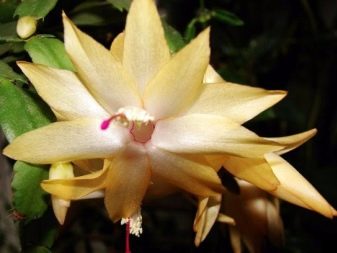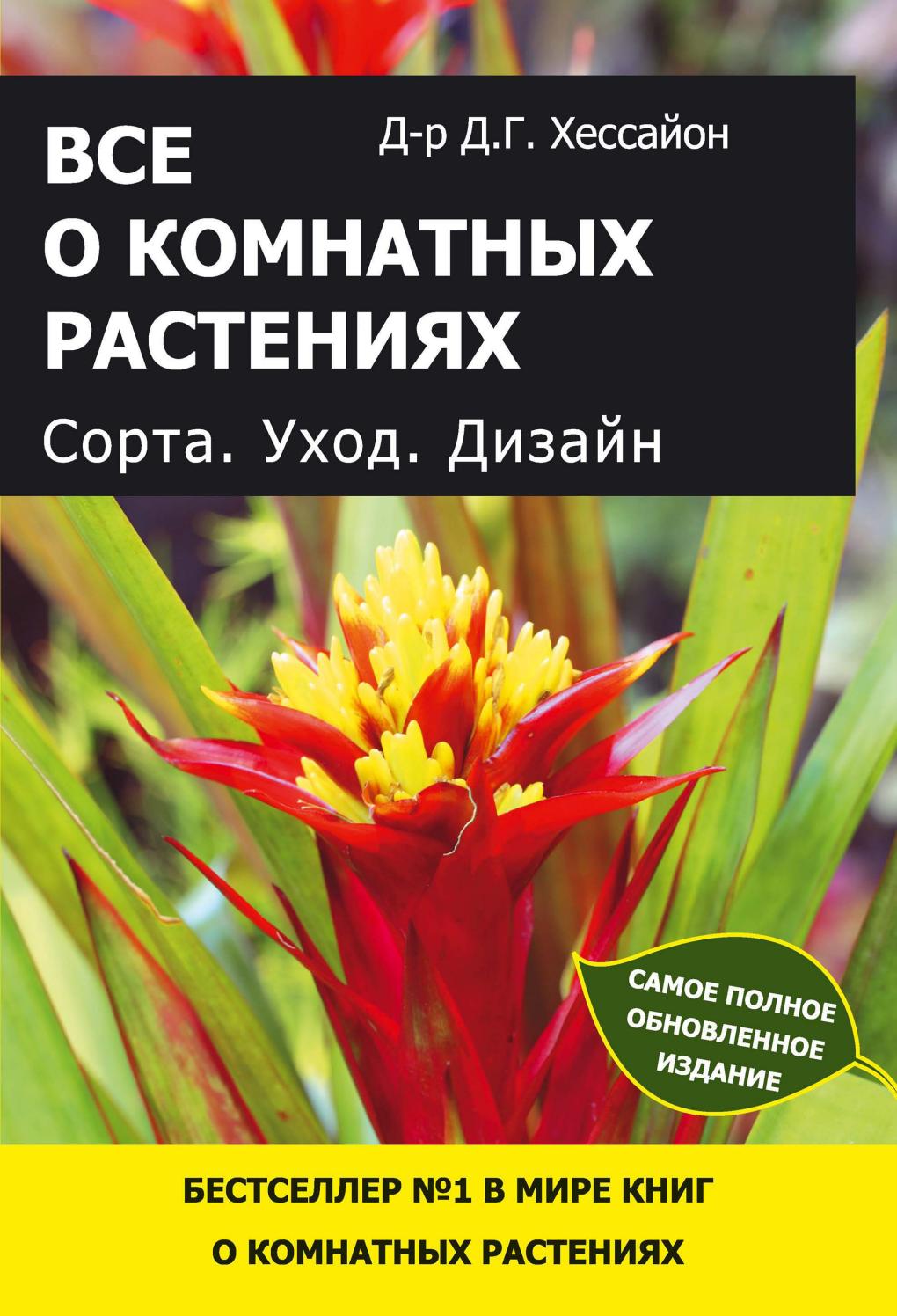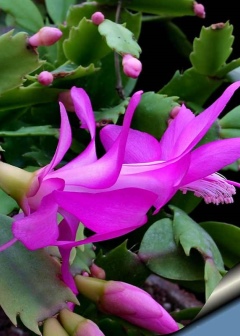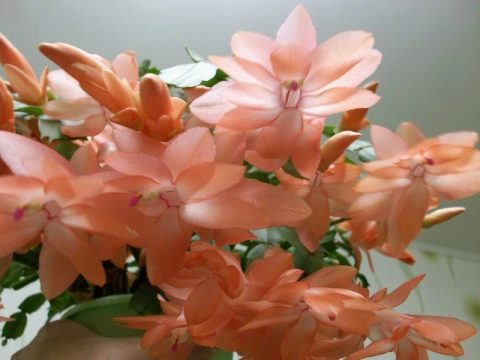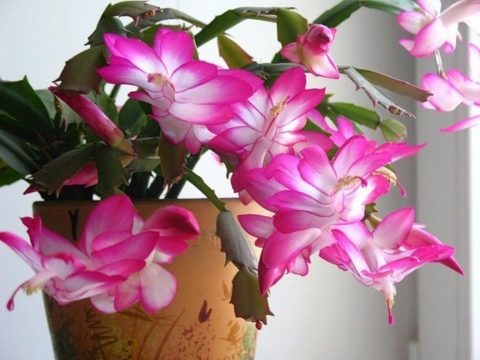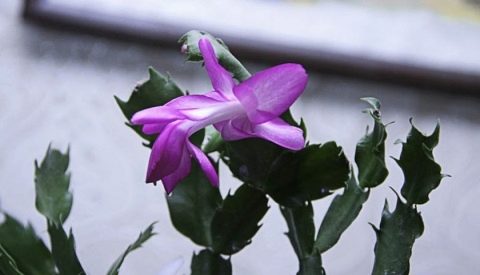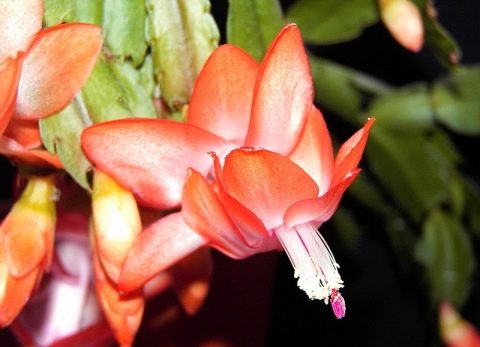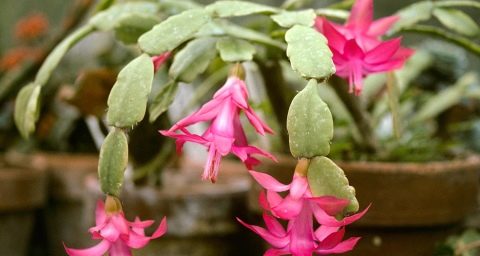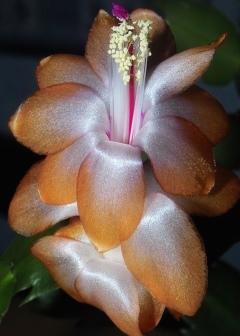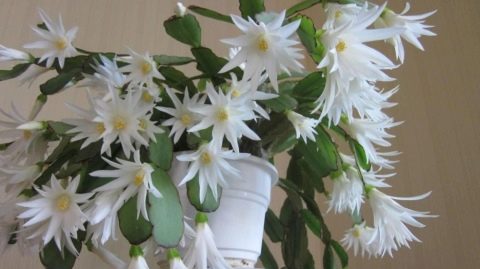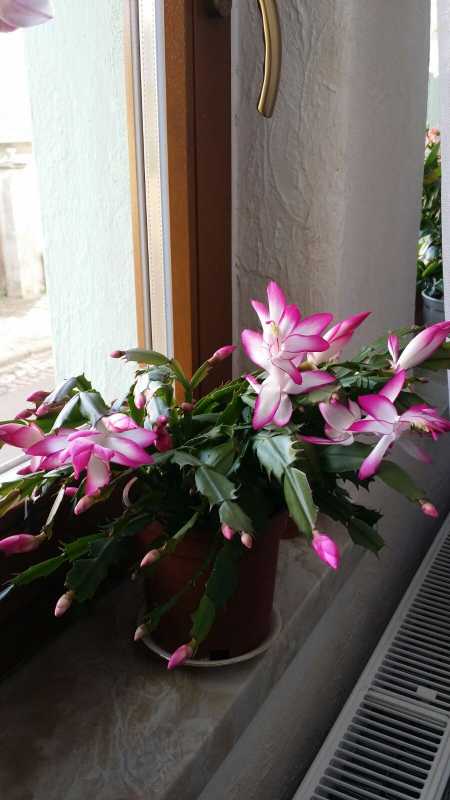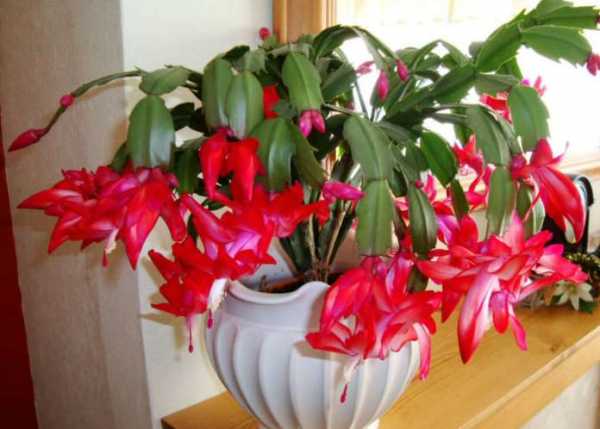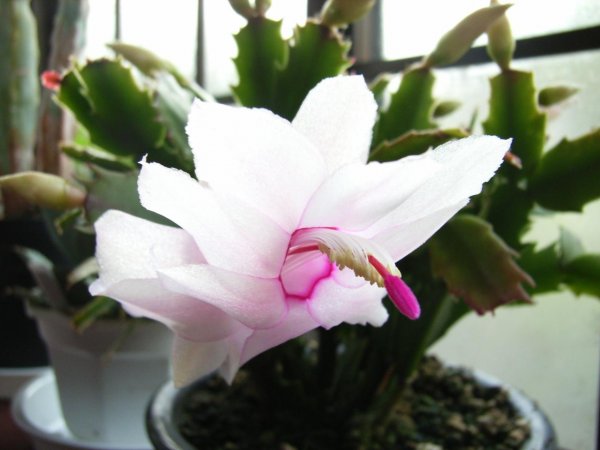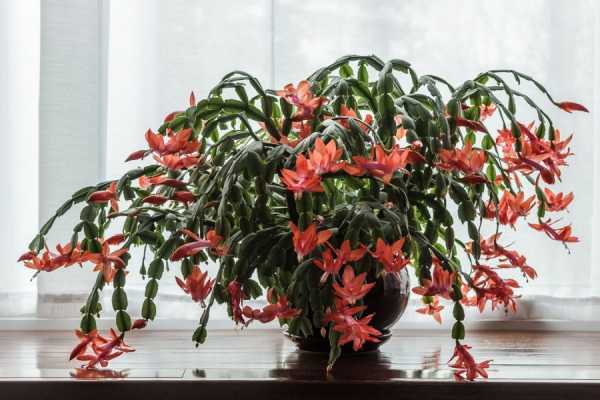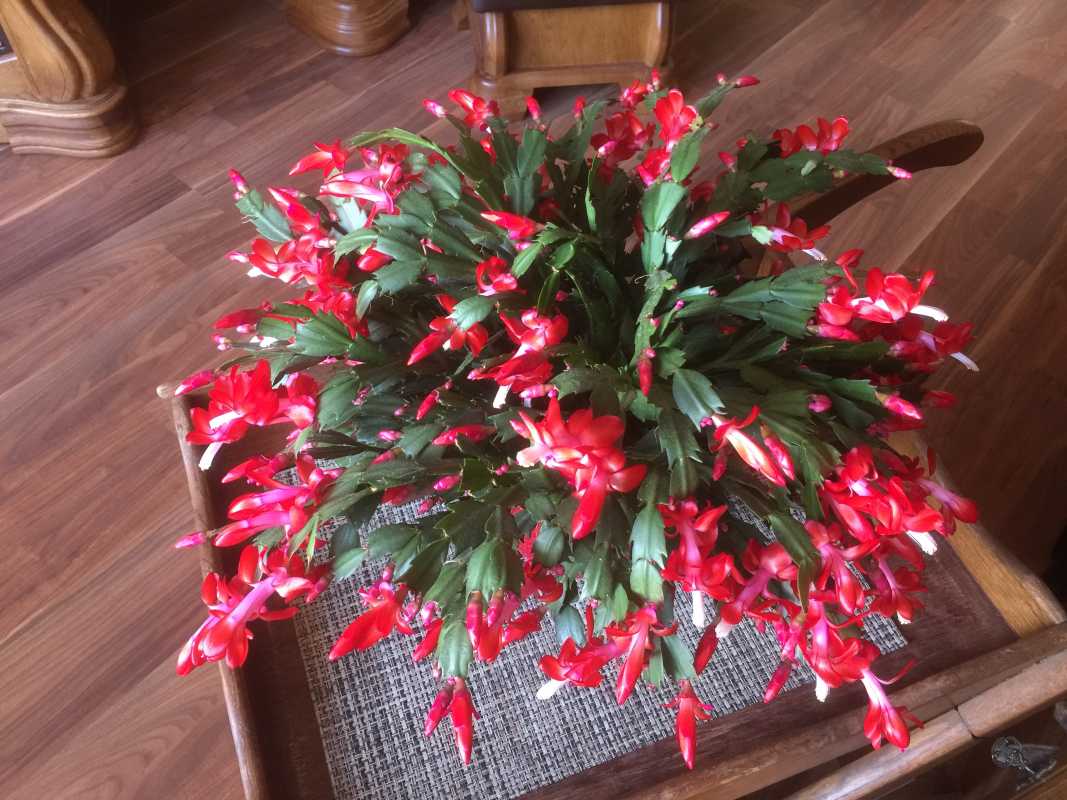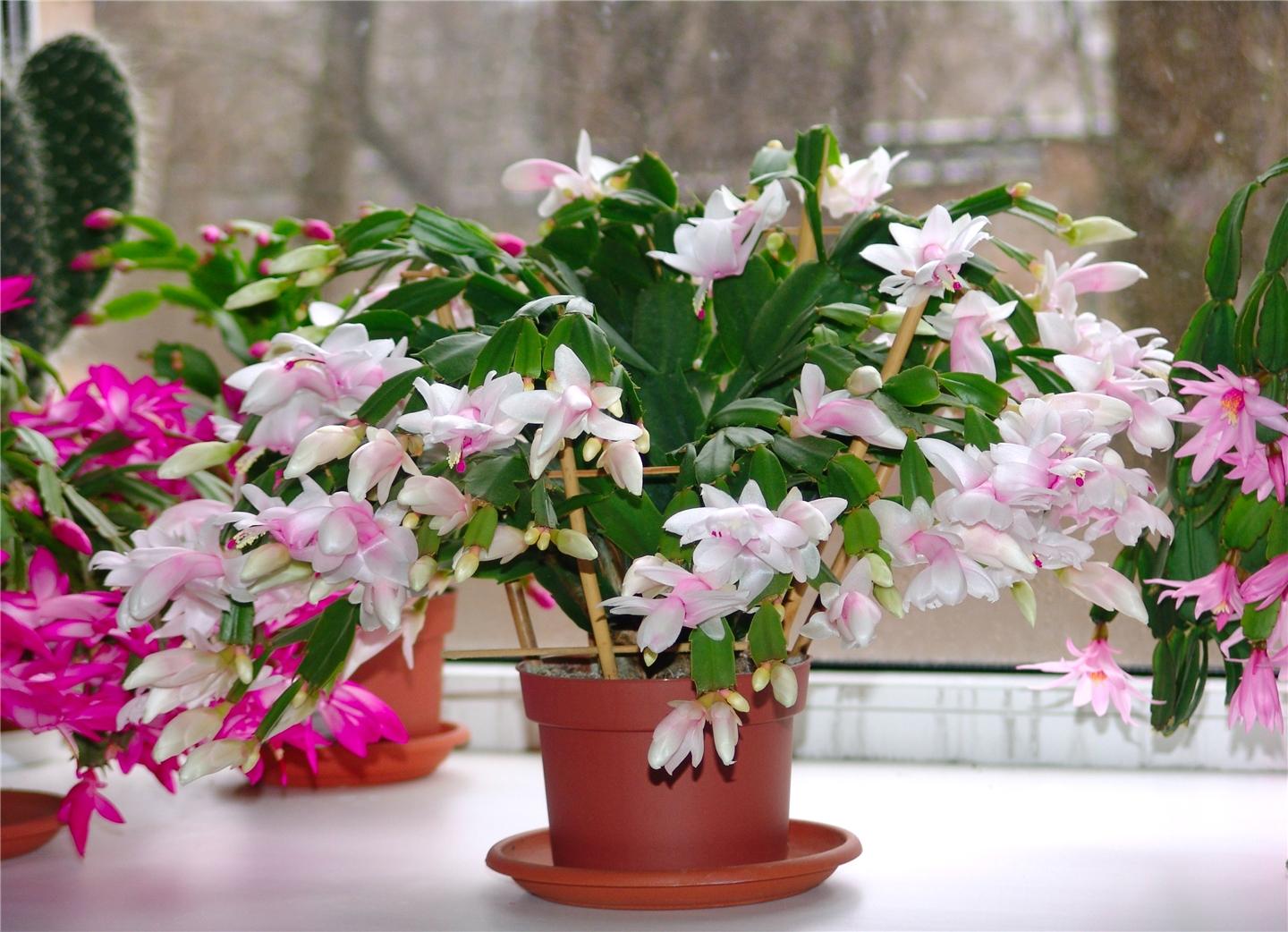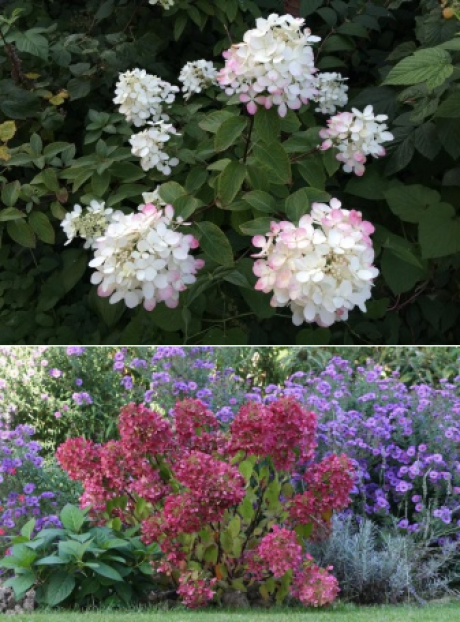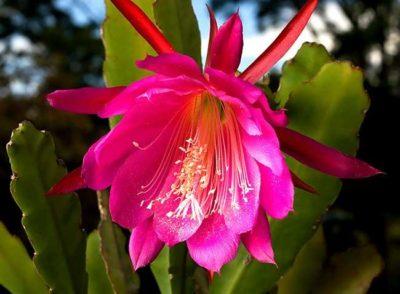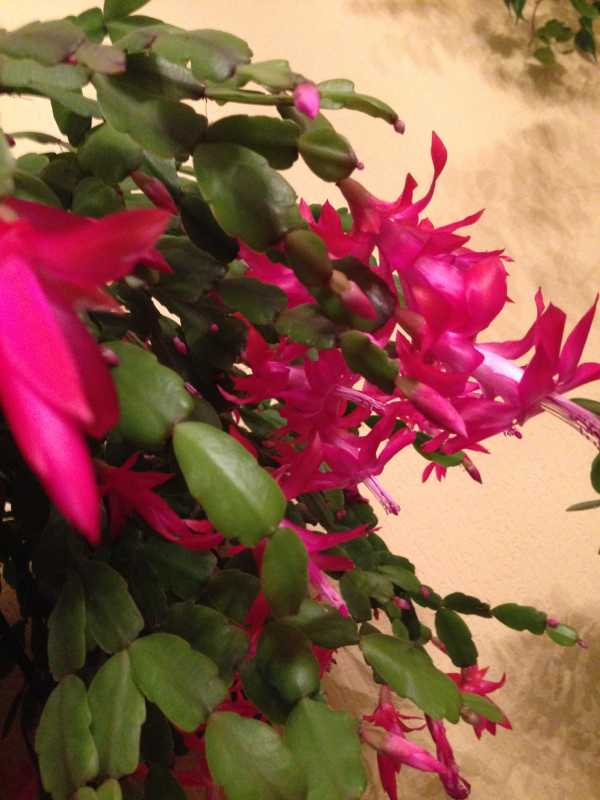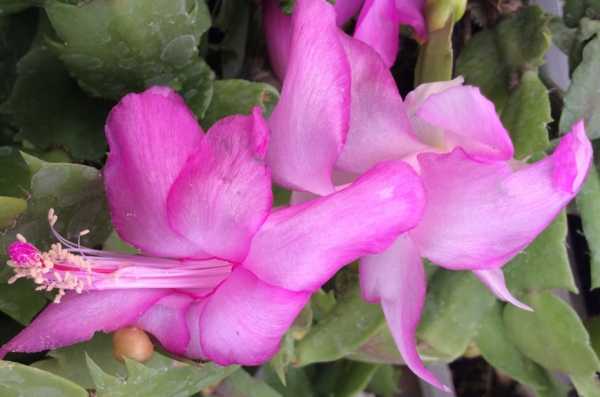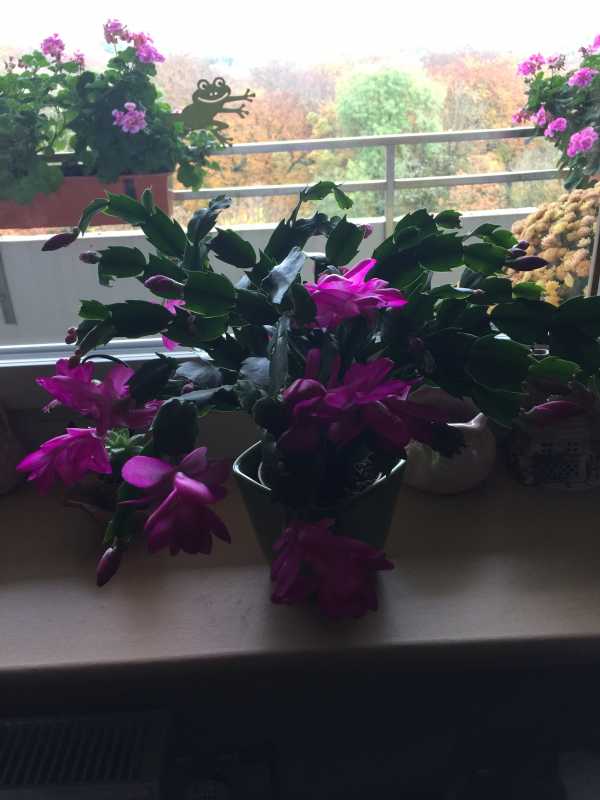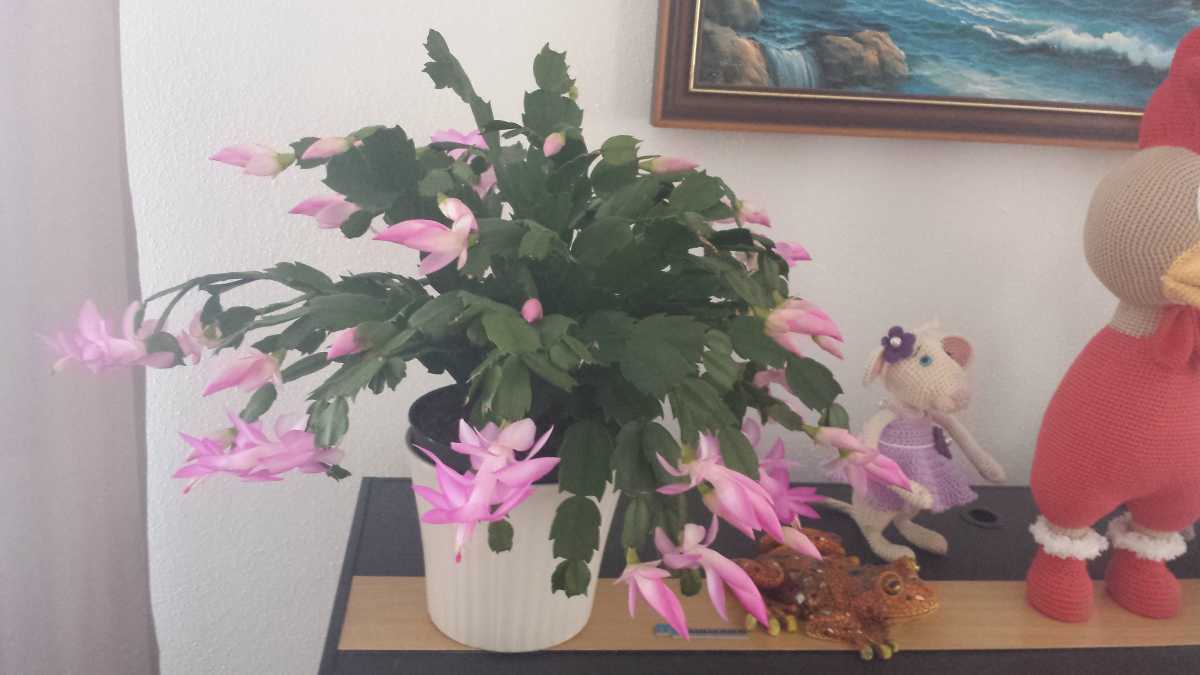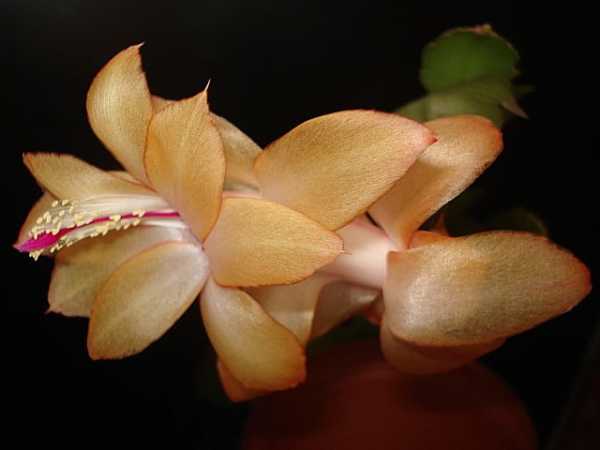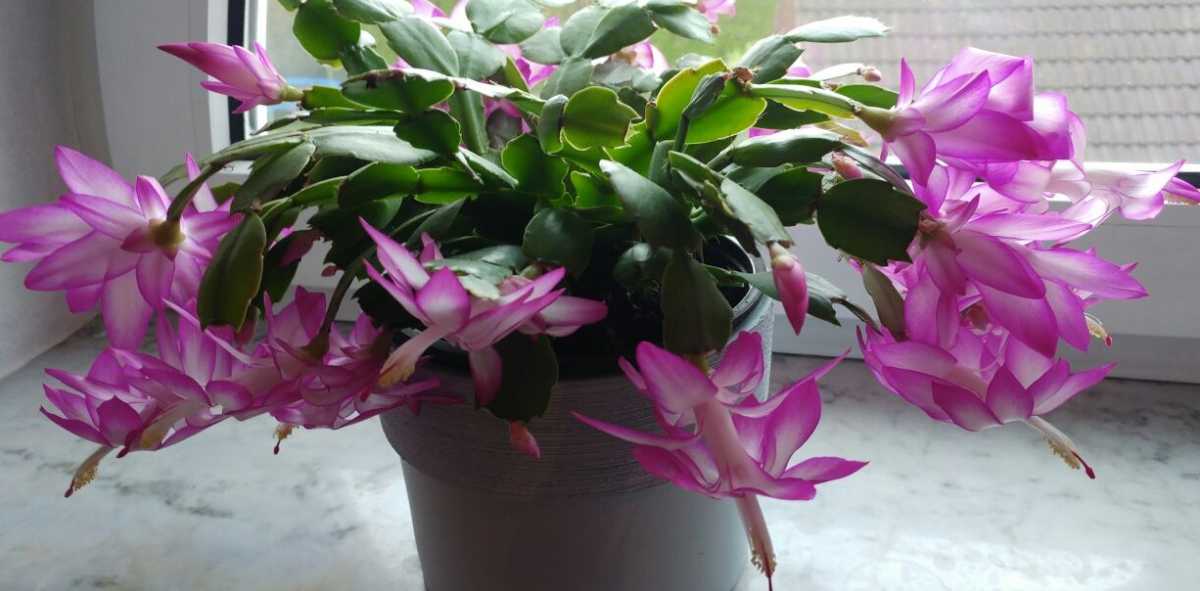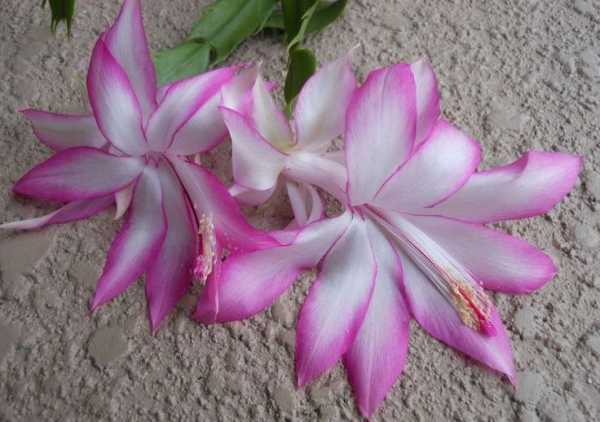Watering and humidity
A beautiful photo of the Decembrists' flowers is simply amazing. But how to achieve such harmony in your own home. Here it is worth adhering to the correct watering and its moisture content. This plant requires abundant and most importantly regular watering.
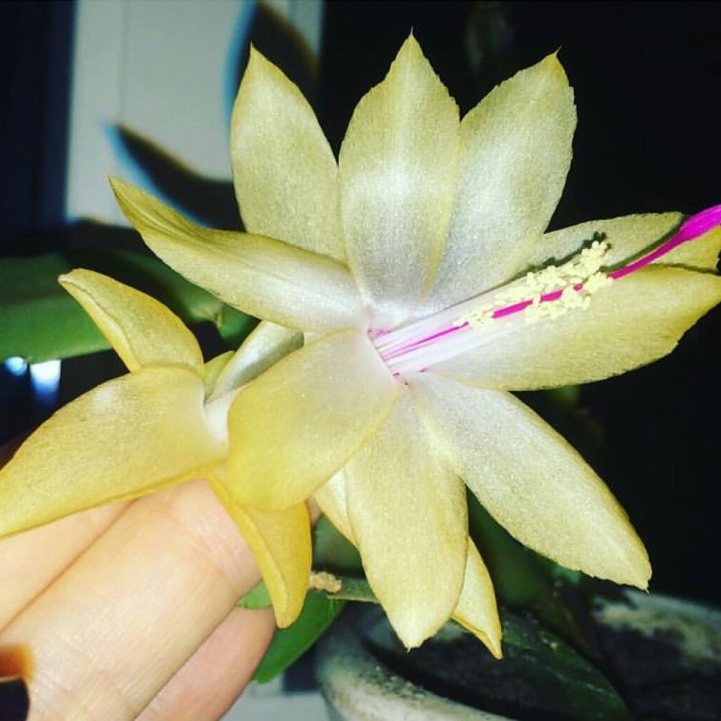
But there should be no stagnation of water here. There should be a small middle ground.

But this view is picky about the water itself
He does not appreciate the limestones that may be present there, and therefore it is important to water with pre-prepared water. This is boiled and room temperature water
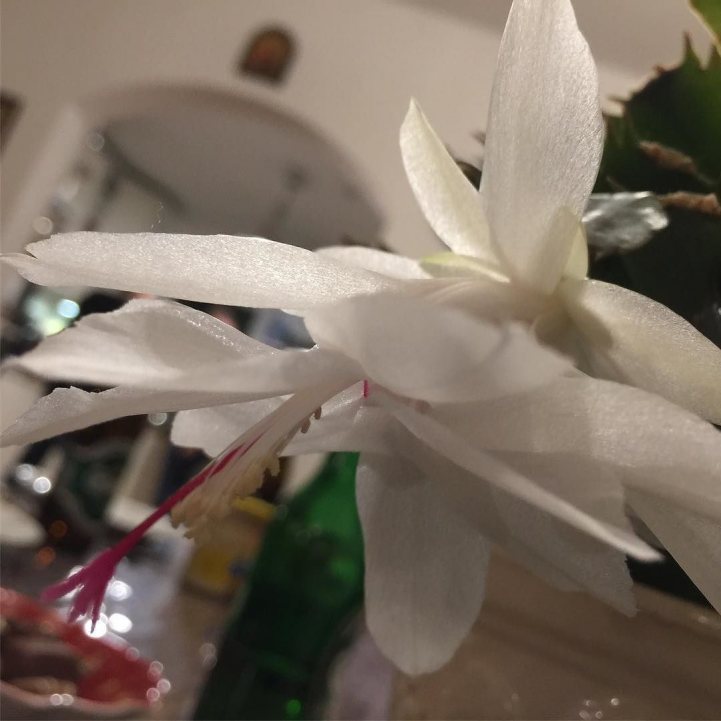
Room humidity should also be medium, high will be too destructive for such a home variety. Also, the plant will require spraying.

Types and varieties of the Decembrist with a photo
Buckley

This variety served as the basis for breeding many others. Its popularity is due to its resistance to external conditions. Buckley (or Buckley) is not capricious and calmly withstands minor cultivation flaws. The size of the bush reaches 50 cm, and the diameter of the flowers is 8 cm.The variety of colors is very large - from white to pink or purple... Shoots have a dark green tint and rather rounded projections.
Buckley's attractiveness is also enhanced by long flowering times. In this variety, it can last from late autumn to March.
White

This large-flowered Schlumberger variety looks both gentle and effective. Due to the size of the flowers during this period, the stems are literally completely hidden behind them.
Truncated

The leaves of the truncated Decembrist have pointed teeth and a light green, sometimes reddish color. The flowers have an unusual appearance: they have two tiers with bent petals. The colors can be very different: white, pink, purple, lavender, orange or even mixed. Thanks to the beautiful hanging of the stems, such a Decembrist can also be used as an ampelous one.
Russeliana

Low grade Decembrist with long shoots. Russeliana leaves are flat and free from chipping. The tube of the peduncle is colored green, but the flowers themselves can have different colors: red, pink or purple.
This variety is also highly popular: in addition to its visual appeal, Russeliana is very unpretentious and resistant to temperature extremes.
Golden Cream

The originality of the variety is the color of its flowers. They have a warm yellow-orange hue. In nature, yellow Decembrists do not exist, therefore the existence of this and other varieties of a similar color is the merit of the breeders. The shoots of such a zygocactus generally remain vertical and have serrations.
Aspen
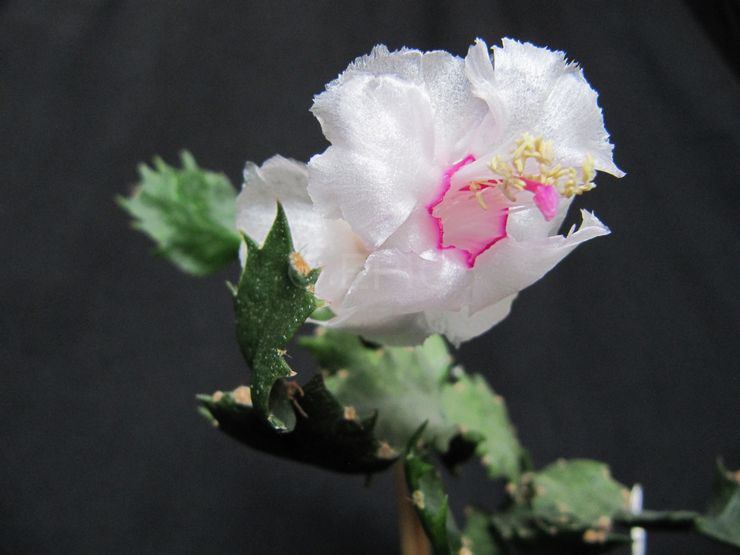
This type of Decembrist is a bit like a carnation: its flowers have double edges. Aspen inflorescences are usually painted white or pale pink and are complemented by a pinkish pistil and yellow stamens. During flowering, this variety looks very solemn and elegant.
Gertner

Thanks to the long and slightly pointed petals, the Gertner flowers slightly resemble a bell. They are usually colored red-orange or pink. Against the background of rich green shoots, such flowers look contrasting and bright. "Leaves" -segments of this species are slightly larger than usual, the stems also differ in length.
Cacti and Succulents Houseplants
Bloom
In the autumn period (from the end of September to the middle of November), for the formation of flower buds, the zygocactus needs to change the conditions:
- Place in a cool place, where the temperature will not be higher than 20˚, but also not lower than 10-13˚;
- Reduce watering;
- The place where Schlumberger will be located should be shaded.
In mid-late November, transfer the Decembrist to a warm place, place it on the windowsill.
During the period when buds or flowers appeared on the Decembrist, it is important not to turn it with the other side to the sun and not transfer it at all, since the Decembrist can throw them off without starting to bloom;
The flowering plant is watered, but not sprayed;
Fertilizers are not needed during flowering.

Plant species
Schlumberger got its name in honor of Frederick Schlumberger, who collected cacti. A little later, the flower received another name - zygocactus, which in translation from Greek meant "rocker". The fact is that during vegetative growth, the segments are stratified only into 2 parts; this feature of the plant caused people to associate it with a rocker.
Schlumberger's truncated

Truncated Schlumberger: the snow-white flowers of the plant with a bright crimson center of irregular shape delight the eye
Truncated (Schlumbergera truncatus)
A perennial plant related to succulents. It reaches a height of 50 cm. The drooping stems of the plant, light green, can reach a length of 30 cm. The stems of Schlumberger consist of leaf-like segments, well curved, with a well-visible jagged edge with sharp teeth. The segment reaches 2.5 cm in width and 5 cm in length. Areoles with bristles are visible at the apex of the segment. They are also located between the denticles.
Flowers appear at the apex of the segments. One flower blooms on one segment, in rare cases 2-3 bilaterally symmetrical flowers can be seen. The flower tube takes on a slightly curved shape. The stamens are clearly visible, as they "fall" outward and go beyond the wide-open outer petals of the corolla.
During flowering, the truncated Schlumberger is covered with caps of white, pale pink, pale lilac, purple flowers. After flowering, a fruit is formed in the form of a red berry, up to 1 cm long.
Schlumberger boucley

Buckleys (Schlumbergera bucklei)
Buckleys (Schlumbergera bucklei)
A medium-sized epiphytic plant, reaching a height of 40-45 cm. The flat, dark green, shiny stems of the plant branch well. The fleshy stems consist of many flat segments, the edges of which are weak and are characterized by slight pubescence. Areoles do not contain thorns.
The flower includes numerous pointed oblong petals and a long yellow tube. The diameter of the flower is up to 8 cm. Depending on the variety, the flowers can be painted in all colors of the rainbow and differ in the duration of flowering. There are even yellow Schlumberger bouclei varieties.
Schlumberger Russelian

Here is such an unusual Schlumberger Russeliana in bloom (Russelliana)
Russeliana (Schlumbergera Russelliana)
An epiphytic, weakly growing plant, reaching a height of 30 cm. The falling shoots have flat segments covered with a glossy sheen.
It is recommended to grow in a hanging planter, since the length of the stems under good growing conditions can reach 1 m. The stems are fleshy, the edges of the shoots are scalloped, there are no thorns in the areoles. The length of one segment varies from 3 to 3.5 cm, the width is about 2 cm.
A well-visible central vein runs along the entire leaf. Under natural conditions of growth in early spring, Schlumberger blooms with red, carmine, pink, purple flowers. Flower petals are oblong, pointed, numerous. A greenish tube emerges from the center.
Schlumberger Gertner

Gertner (Schlumbergera gaertneri)
Gertner (Schlumbergera gaertneri)
Unlike other members of the genus, Gertner is a large plant with red-orange flowers. The flower petals are strongly pointed, the leaf segments are 6 cm long.
A distinctive feature of Schlumberger Gertner's are huge flowers with pronounced pointed petals and rounded segments
Cypress is a graceful plant that is beneficial to health.Description of 10 varieties suitable for growing at home, care and reproduction (50 Photos & Videos) + Reviews
Conditions for growing lupine on the site
Lupine is not picky about growing conditions, however, there is a certain agricultural technique for its breeding, which is recommended to be followed in order to get good results.
Location. Lupine is photophilous, but it also grows in partial shade. It is desirable that suitable predecessors - winter and spring cereals - grow in the selected area up to lupine. It is not recommended to plant it after leguminous plants, there is a high probability of being damaged by diseases and pests.
If lupine flowers are grown in a place not protected from the winds, it is better to tie them to a support, since they have a thin stem. Strong gusts of wind can break the plant. For support, an ordinary wooden pole or a thin, but strong branch is suitable.
The soil. Prefers loose, well-drained, nutritious soils with neutral or slightly acidic reaction. On acidic soils, lupine does not bloom, and the foliage loses its brightness. On the areas where lupins grow, lime is added every 2 to 3 years.
On alkaline soils, the likelihood of developing diseases of this culture is high. If this is the soil in the garden, it is necessary to water the area with a weak acidic solution or add peat before planting lupine flowers.
Basic rules of care
You can grow a healthy and beautiful plant by creating favorable conditions for it and providing it with proper care.
Lighting and humidity
 Unlike many succulents, zygocactus do not like direct sunlight, temperature drops and dry air. In winter, a flowering plant can be placed on the southern windowsill, and in spring and summer, the Decembrist will feel good about the northern and eastern windows.
Unlike many succulents, zygocactus do not like direct sunlight, temperature drops and dry air. In winter, a flowering plant can be placed on the southern windowsill, and in spring and summer, the Decembrist will feel good about the northern and eastern windows.
In order for the bush to grow evenly, it is periodically recommended to turn it to the light in different directions. At the same time, a plant that is blooming and gaining buds cannot be rotated and moved from place to place, since the flowers will immediately fall off.
Decembrists love humid air, therefore, in the hot season or in rooms with radiators turned on, it is recommended to spray them daily and bathe them in the shower from time to time. The soil in the pot is preliminarily covered with foil. The air humidity around the flower can be increased by using side-by-side wet pebble trays.
Too dry air can lead to dropping of buds, so in winter zygocactus are sprayed more often. However, this must be done so that water does not fall on the flowers.
Watering and feeding the Decembrists
Flowering zygocactus should be watered sparingly, but so that the soil in the pot is always moist. During the dormant period, watering is reduced, and the plant is watered only afteras the potted soil becomes dry. In the fall, the Decembrist preparing for flowering should be kept in cool conditions and rarely watered. Watering is carried out with settled water at room temperature.
The Decembrist is fed in the spring once a month with flower mineral fertilizers for cacti. It is necessary to ensure that the nitrogen content in them is small, since this element in succulents can cause root rot. In the summer, the plants are fed every fifteen days, and in the fall, no fertilization is applied at all.
Temperature regime
The Decembrist is completely undemanding to temperature. It can grow at temperatures of +37 degrees, and at + 2C. However, it is better not to create such stressful conditions for the plant.
In order for the zygocactus to bloom magnificently, it is necessary to stimulate the laying of buds, creating a period of rest for this:
- In autumn, when the air temperature in the room is above + 23C, the buds will not form. The plant should be kept in cool rooms with a temperature of + 12- + 16C.
- In the active phase of flowering, the Decembrist needs a temperature from + 18C to + 20C.
- As soon as the bush fades, it is again placed in a cool place.
How to water a flower
Do not think that the white Decembrist, like most of its "relatives" of cacti, does not need regular watering. On the contrary, Schlumberger does not tolerate drying out of the soil, but excess moisture also harms the plant. Therefore, you need to be extremely careful with watering a flower.
As a rule, the soil should be moistened once a week. If it is hot in summer, then increase irrigation, and in winter, on the contrary, reduce it. Before the procedure, check the earthen lump, if it is not dry enough, then instead of watering, spray the foliage of the plant. This will bring the flower much more benefit than excess moisture.
In the fall, during the dormant period, reduce watering to a minimum. At this time, it is advisable to keep the flower on "dry ration". In November, start increasing watering, and gradually bring it back to normal.
Use only filtered, soft water for humidification at any time of the year. Let it sit for at least 2 days before use.
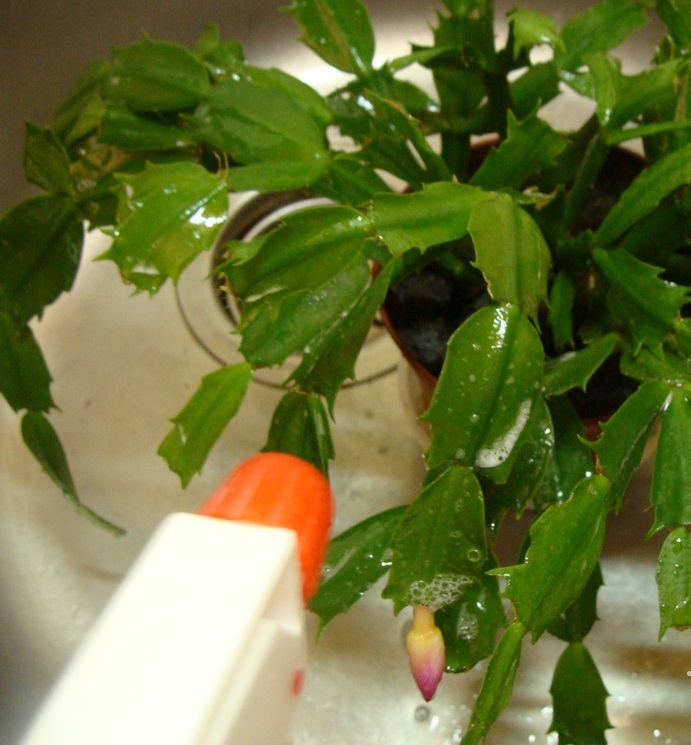
Tall annuals suitable for the garden
Tall annuals can become a central plant in a long-tiered flower bed or act as a tapeworm.
Flowers in warm colors
Belamkanda, a Chinese orchid or leopard lily, is a surprisingly ornamental plant. Every morning, lily-like flowers bloom, which die in the evening, making room for the next buds in the sun. Group planting of several copies looks impressive solo or as an accent in the center of the flower bed. Exceptionally sunny plant. Photo:
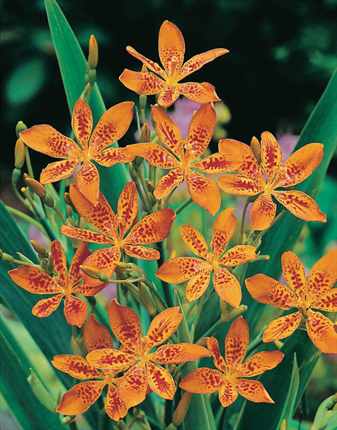
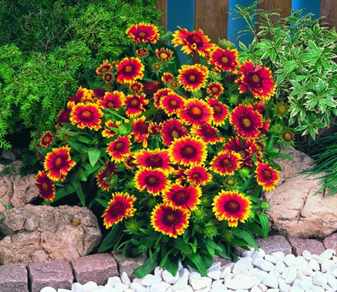
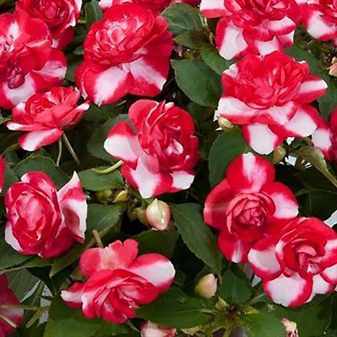
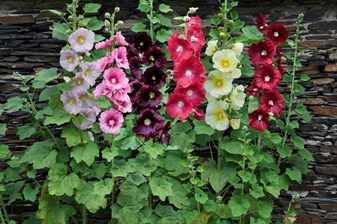
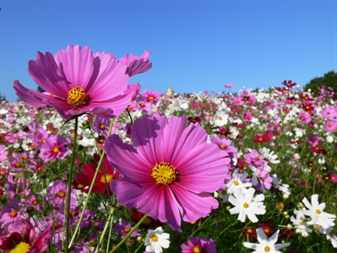
Tall plants with cool colors
- Asters are flowers of the second half of summer, they do not lose their decorative effect until the very frost. All shades of blue, purple, lilac - cold stars in the flower bed
- Heliotrope is a thick head of bright blue or deep purple inflorescences.
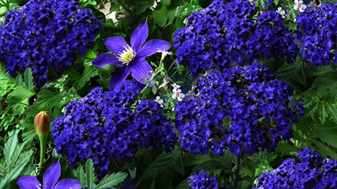
Types of Schlumberger with snow-white flowers: description and photo
White Christmas
Probably one of the most famous varieties of light-colored zygocactus. The bush can reach a height 50 cm. It has gained popularity around the world for its large snow-white buds with a bright pink pistil, as well as long flowering. By the shape of the inflorescence slightly resembles a cyclamen.
Bridgeport
Famous among zygocactus for its uniqueness. It has large flowers with wide oval petals, although the bush itself is rather small, no more than 30 cm in height.
Angel dance
Milky-white flowers bloom on dark green shoots, and the flower tube and pistil are of the same completely white hue.
Unlike other white Decembrists, whose flowers can turn pink from the cold, Angel Dance never turns pink.
He is called an albino among zygocactus.
Aspen
Differs in terry border on the edge petals. The buds can be snow-white, or they can have a slight pinkish tint.
Windsor
Also has inflorescences with a snow-white tint. Due to the fact that its reproduction has a number of difficulties, it is rarely possible to acquire a variety where it is possible.
Variegated with white flowers
There are variegated varieties of zygocactus with various shapes and colors. For example, Variegated with white flowers has charming completely white peduncles against the background of green shoots with yellow blotches.
Common types and varieties of gerberas in the photo
In nature, there are more than 80 species of gerbera that grow in different parts of the world. The homeland of most of them is South Africa, there are the following species:
These and other numerous plant species for the most part are not used in modern floriculture, and therefore are of interest only to a narrow circle of professionals.
The most popular and famous gerbera species is Gerbera jamesonii Bolus ex Hook.f., Jameson's gerbera. It was from her discovery that the introduction to the culture of this wonderful flower began.
At the end of the 19th century, the Scottish scientist Robert Jameson noticed and described a type of gerbera that grows in the Transvaal, an area in South Africa, after which in some English-speaking countries the gerbera began to be called "transvaal daisy" (transvaal daisy). It was this species that became the ancestor of all modern varieties of gerberas.
Through the efforts of breeders by crossing the Jameson gerbera and the green-leaved gerbera (G. Viridifolia), more than a thousand varieties and varieties of hybrid gerberas of various colors and sizes, with simple and double inflorescences, have been created. Various garden forms and varieties of Jameson gerbera are widely used, especially in indoor floriculture.
Clones and varieties grown in industrial floriculture are conditionally subdivided into a number of technological groups that differ in size and type of inflorescences:
In indoor floriculture, compact forms of Jameson's gerbera have become widespread, with a peduncle height of no more than 25 cm.Cultivars such as Gerbera Happipot, Gerbera Hummingbird, Gerbera Ilios and Gerbera Parade are used as pot crops. One of the famous varieties of indoor gerberas Durora mix is characterized by large semi-double flowers, compact size, popular due to its unpretentiousness and greater durability compared to other similar varieties.
It is not possible to describe all existing varieties of gerberas within one article. Let's note just a few more popular varieties of different colors common in our country:
Subtleties: how to achieve lush flowering
In order to truly enjoy the fabulous flowering of the Decembrist, you need to know its natural features and, if possible, bring the content as close as possible home to natural habitat.

Lush bloom depends on proper care during the periods of the Schlumberger development cycle
For a plant, care will depend on the phase that it passes in a certain period of time:
- from March to September - the growing season
- from September to early November - rest time
- second decade of November - January - flowering period
- from February to March - another period of rest
March-September: plant care
- In March, the Decembrist begins a period of active growth. At this time, an increase in green mass is observed, the plant responds well to fertilization. As fertilizers, you need to choose complex fertilizing with a minimum nitrogen content, since excessive application of nitrogen-containing fertilizers can lead to decay of the root system.
- During growth in the warm season, you can take the plant pot out to the terrace or balcony to give the flower a lot of pleasure. Do not expose the pot to the open sun, as Schlumberger will get burned foliage. It should be noted that under the open sky the earthen lump will dry out faster, so more frequent watering will be required, but without excessive waterlogging.
September-early November: poisoning the plant to rest
- The first decade of September is characterized for the plant by the beginning of the laying of flower buds. This process cannot be noticed, but you should be aware of it. The rest period is an important time period for Schlumberger and a responsible one for the grower. If you do not take into account the characteristics of the plant, you can not wait for flowering.
- Starting in September, watering is minimized, but the earthen coma is not allowed to dry out completely. The room temperature should also be reduced. If possible, it is recommended to move the flower pot to a cool room, since it is hardly possible to reduce the temperature in an ordinary apartment.
- An unheated loggia will serve as an optimal place for keeping a Schlumberger for planting flower buds.
- At this time, a temperature drop of up to +3 ° C is permissible. It will not be critical for the plant; on the contrary, it will stimulate bud formation.
- During dormancy, the plant should be rarely watered.Such a shake-up will result in a lush and abundant flowering.
Second decade of November - January: flowering period
- In mid-November, the plant is brought into the room, accustomed to a constant temperature. Soon it will respond gratefully to the care of the owner and will be covered with buds.
- At this time, fertilizing with fertilizers containing potassium and phosphorus is needed. It is recommended to feed with calcium nitrate once.
February-March: another dormant period
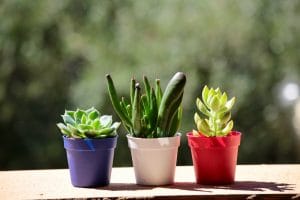
Succulents: Description, Species, Growing, Planting, Reproduction and Home Care, Useful Properties (70+ Photos & Videos) + Reviews
What varieties of Schlumberger have this color: description and photo
The Decembrist plant can be found in almost every home or organization. But few people know that in addition to the usual shades, a flower can have a yellow color. This shade is not a characteristic color for a plant in natural conditions. Red, pink, white and orange flowers can be found in the tropics.
Reference. Breeders of different countries have been working on the breeding of hybrids for more than one year. The "parent" of all kinds of Decembrists with yellow flowers was "Gold Charm".
From buds with an orange tint, breeders selected fifty thousand seeds in which the yellow component was the main one. After planting them, one bush with a yellow tint was grown and crossed with a white Schlumberger bush, in the end it was possible to collect two hundred seeds. Of these, one hundred and fifty bushes sprang up, one of which became the founder of all the yellow varieties of the Decembrist.
This plant has up to thirty petals of various sizes and shapes. The size can range from four to eight centimeters in length. Leaves can be wide or narrow, or pointed at the ends. Further, it is told about the Schlumberger varieties with yellowish flowers, brief descriptions and photos are given.
Gold sharm
This variety has yellow-green buds. As they grow, they turn yellow in the center and orange at the edges.
Important! In the half-open position, the flower looks like a candle flame, which is why it was so named.
When the time comes for it to fade, all the red colors in the plant turn into yellow shades.
Cambridge
A plant with bright yellow hues. The bush itself has vertical stems. The hybrid was bred by crossing Gold Sharm and Cristmas Flame.
Golden fever
The variety has large flowers in several tiers. Bright yellow petals with crimson stamens give the plant a special zest.
Golden Cream
The variety was bred by Australian breeders. It differs from the previous ones by the unique color of the inflorescences: the yellowish color turns smoothly into a warm yellowish-golden tint.
Attention! Inside flowers are pale pink stamens.
Gold fantasy
The variety appeared as a result of hybridization of Gold Sharma, therefore, in the shape of the bud and shoots, it is very similar to it. The main difference is in the color of the flowers: the blossoming buds have red and purple hues, but later the leaves turn yellow.
Golden orpheus
The flower is bred by Danish breeders. Its distinctive feature lies in the wavy shape of the petals and their color: pale yellow, almost white in the center and bright yellow at the ends.
Reference. The entire bud is tinted with pink strokes.
Buckley
The stems of this plant are well developed and have many lateral shoots. Segments of the flower are slightly pubescent with jagged sides of a rich green hue. The buds of the plant are like bells of a juicy yellow hue.
Sanibel
The variety produces delicate and beautiful buds during flowering. The flowers have a pink heart, purple streaks and white stamens.
Important! The Decembrist is a long-lived flower. In good conditions, he can live for more than fifteen years.

